Статьи журнала - Журнал стресс-физиологии и биохимии
Все статьи: 984
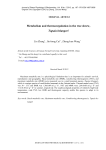
Metabolism and thermoregulation in the tree shrew, Tupaia belangeri
Статья научная
Maximum metabolic rate is a physiological limitation that is an important for animals' survival, reproduction and geographic. Basal metabolic rate (BMR), nonshivering thermogenesis (NST), and maximum metabolic rate (MMR) were measured was in a small mammal species, Tupaia belangeri, which is a unique species of small-bodied mammals in the Oriental realm. Thermal neutral zone (TNZ) was 30 - 35°C and BMR was 1.38±0.09 ml g-1 h-1. NST and MMR were 2.64±0.08 ml g-1 h-1 and 7.14±0.38 ml g-1 ·h-1 in summer, respectively. The ecophysiological properties of relatively high body temperature, wide TNZ, low BMR and thermogenic capacity enable this species to adapt to its environment.
Бесплатно
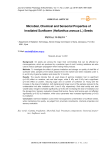
Microbial, Chemical and Sensorial Properties of Irradiated Sunflower (Helianthus annuus L.) Seeds
Статья научная
Background: Oil seeds are among the major food commodities that can be affected by microorganisms, which are produced by a particular type of mold. Ionizing radiations are also used to reduce pathogen propagation when trading these products. Methods: To investigate the effect of gamma irradiation and storage on quality of shelf-life of sunflower seed, samples of the seeds obtained from the market have been irradiated under 3, 6, and 9 kGy of gamma radiation and stored for 12 months. Results: The results indicate that, all used doses of gamma irradiation had no significant (p<0.05) effect on moisture, ash and total sugar, while 6 kGy and 9 kGy had a significant (p<0.05) effect on protein, reducing sugar and oil content of sunflower oil. Along with the increase in the dose of irradiation, both bacterial and fungal count of the samples reduced to the undetectable limit after irradiation with 3 and 9 kGy respectively. Both total acidity and total volatile basic nitrogen increased significantly (p<0.05) with increasing the dose of irradiation and the storage time. Sensory evaluation showed that texture, flavour and texture were not affected significantly (p<0.05) by irradiation, while colour parameter was increased significantly (p<0.05) by irradiation. Conclusion: Gamma irradiation could arrest microorganisms contamination of sunflower seeds, while maintaining the quality, as judged from proximate constituents, chemical properties and sensory evaluation.
Бесплатно
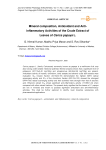
Статья научная
Carica papaya L. (family Caricaceae) commonly known as papaya is a well-known fruit crop also having under-utilized medicinal potential. Mineral analysis shows that a significant level of potassium (207.10±0.40 mg/100g) and phosphorous (65.60±0.59 mg/100g) are present. Antioxidant activity of hexane, chloroform, ethyl acetate and ethanol crude leaf extracts were evaluated. IC50 hexane fraction (321.82±0.78) demonstrated the highest ABTS radical scavenging activity and IC50 of the chloroform fraction (623.23±1.32) showed the strongest DPPH free radical scavenging activity and their activities were stronger than that of ascorbic acid. Ethanolic extract IC50 shows significant anti-inflammatory activity (173.66±1.24) when compared with other extract fractions. The present study signifies that the leaves of C. papaya are rich in minerals and known to possess significant antioxidant and anti-inflammatory activities. This shall be further explored to identify novel bioactive substances with pharmaceutical applications.
Бесплатно
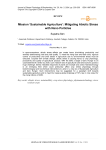
Mission ‘sustainable agriculture’: mitigating abiotic stress with nano particles
Статья обзорная
In agro-ecosystems, abiotic stress effects can create havoc diminishing productivity and severely deteriorating yield and yield quality. To meet the rising food and feed crisis, rigorous control of productivity and yield losses in agriculture due to environmental stress must be executed. Coupled with climate change, abiotic stress is causing havoc to crop physiology, productivity and quality of agricultural produce. With the SDG 2 target of Zero Hunger to an unprecedented 8.5 billion by 2030, such massive loss of agricultural yield and economy poses a huge challenge. Stress mediated responses of plants are multiple and varied. Nanotechnology is an emerging field which could profoundly affect crop stress physiology through biotechnological and biochemical interventions to usher in a new era of Sustainable Agriculture and Zero Hunger. Such interventions may be suggested for a paradigm shift towards sustainable agriculture and to meet the massive global challenge of 70% rise in crop output for the rising millions of 2050.
Бесплатно
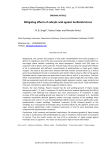
Mitigating effects of salicylic acid against herbicidal stress
Статья научная
Background, the context and purpose of the study: Pendimethalin [N-(1-ethyl propyl)-2, 6-dinitro-3, 4 xylidine] is one of the most commonly used herbicides. It induces harmful effect on non-target plants besides controlling the weed emergence. Salicylic acid (SA) plays an important role in abiotic stress tolerance. Present study was to assess the comparative efficacy of SA in combination with different concentrations of pendimethalin on black gram (Vigna mungo). The seeds of test plant were treated with field relevant concentrations (2, 5 and 10 ppm) of pendimethalin (P) and in combination with SA (0.5 mM) to observe effect of SA against herbicide toxicity. Experiment was performed in petri dish as well as in pot culture. The toxic effect of pendimethalin and SA on seed germination (SG), radicle length (RL) and mitotic index (MI) was evaluated in petri dish culture. Seedling height, pigments, protein, sugar contents and lipid peroxidation (LP) of 15 days old seedling were measured in pot culture. Total antioxidants (TA) were monitored as plant defence against oxidative stress. Results, the main findings: Results showed that SG and seedling growth of Vigna mungo decreased under P1, P2 and P3 treatments. RL and MI were also reduced significantly (p3 treatment. A slight increase of SG and seedling growth was observed in P2 treatment compared to P1. Herbicide treatment remarkably declined pigment, protein and sugar contents of the seedlings when compared with control. TA and malondialdehyde (MDA) content increase significantly under pendimethalin treated seedlings. Combined treatment (P+SA) elevated growth of the seedlings. As a consequence of herbicidal stress, SA enhanced SG, RL, MI, pigment, protein and sugar content significantly. Under combined treatments, LP and TA were decreased when compared with pendimethalin treatment. Conclusions, brief summary and potential implications: SA enhanced growth of Vigna mungo not only in combination with pendimethalin but also in treatment with SA alone as compared to control. Thus the results reveal, the role of SA in protection of Vigna mungo against herbicidal stress is apparent. The results are discussed in light of recent information.
Бесплатно
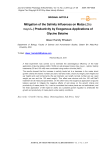
Статья научная
A field experiment was carried out to estimate the advantageous efficiency of the foliar application of glycine betaine (GB) (10mM) on salt-stressed maize ( Zea mays L.) plants. Salinity treatments (50 and 100 mM) were conducted using sodium chloride (NaCl). The results showed that the increase in salinity levels led to a decrease in the maize shoot growth criteria (the leaves number per plant, leaf area index, shoot dry weight, plant height and ear height) and yield components (the ear diameter, ear length, kernels number per ear, seed weight per ear and the 100 seed weight). This effect was obvious with the 100 mM NaCl treatment for all measured parameters. On the other hand, the exogenous application of glycine betaine seemed to mitigate the negative effects of salt stress on the growth criteria and productivity of maize plants. So, it can be concluded that maize plants are not salt-tolerant, and the foliar application of GB might be useful as a possible growth regulator to ameliorate the growth and productivity of maize plants under salinity conditions.
Бесплатно
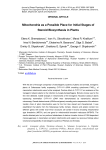
Mitochondria as a possible place for initial stages of steroid biosynthesis in plants
Статья научная
With the aim of thorough comparison of steroidogenic systems of plants and animals, transgenic plants of Solanaceae family expressing CYP11A1 cDNA encoding cytochrome P450 SCC of mammalian mitochondria were further analysed. Positive effect of CYP11A1 on resistance of the transgenic tobacco plants to the infection by fungal phytopathogene Botrytis cinerea was for the first time detected. Subtle changes in mitochondria of the transgenic Nicotiana tabacum plants expressing mammalian CYP11A1 cDNA were demonstrated by transmissive electron microscopy. Genetic determinants (cDNAs and genes) encoding main components of the electron transfer chain of plant mitochondria were for the first time cloned and characterized. It was established that plants from the Solanaceae family (tomato, tobacco and potato) contain two different genes with similar exon-intron structures (all contain 8 exons) encoding mitochondrial type ferredoxins (MFDX), and one gene for mitochondrial ferredoxin reductase (MFDXR). The results obtained point out on profound relatedness of electron transfer chains of P450-dependent monooxygenases in mammalian and plant mitochondria and support our previous findings about functional compatability of steroidogenic systems of Plantae and Animalia.
Бесплатно
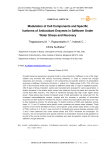
Статья научная
Drought tolerance represents a growing threat to crop productivity. Safflower is one of the major oilseed crop enriched with various nourishing elements. In order to unravel the drought responses and recovery, a changes in cell components and specific isoforms of antioxidative enzymes in safflower (Carthamus tinctorius L. cultivar A1). Water stress (0.0%, 75%, 50% and 25% of soil moisture levels) was induced to safflower plants after 21 days of vegetative growth. After 8 days of stress imposition, plants were harvested and analysed for various parameters. A drastic decrease in the relative water content was observed during the stress and resumed the normal level after recovery. The extent of membrane damage was high under higher stress levels. These plants also showed increased levels of lipid peroxidation as evidenced from the increased malondialdehyde content, coupled with the increase in activities of antioxidant enzymes and their isoforms whereas the values in stress-recovered plants observed to be near to their respective controls. On activity gels, 12 distinct isoforms of SOD were detected; among these 10, 11 and 12 isoforms were specific under moderate and severe water stresses. Three isoforms of CAT were identified of which 2 were specific under severe water stress. In the case of POD, isoforms 2, 4, 6 and 7 were common for moderate and severe stresses whereas, POD 3 and 5 were observed only under severe stress and POD1 remained as unchanged. On recovery, the cell components and specific isoforms of antioxidative enzyme levels appeared to be that of the normal controls could be considered and used as selection criteria for improving safflower drought tolerance.
Бесплатно
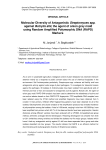
Статья научная
As an aim in sustainable agriculture, biological control of plant diseases has received intensive attention mainly as a response to public concern about the use of chemical fungicides in the environment. Soil Actinomycetes particularly Streptomyces spp. enhance soil fertility and have antagonistic activity against wide range of plant pathogens. To investigate for biocontrol means against the pathogen, 30 isolates of Actinomycetes have been isolated from agricultural soils of Kerman province of Iran and assayed for antagonistic activity against Botrytis allii, the agent of onion gray mold. RAPD DNA analysis has been used to determine the relatedness of active and non-active isolates based on their RAPD-PCR fingerprints. PCR amplifiable DNA samples have been isolated using the CTAB method and amplified fragments have been obtained from 5 random 10-mer primers. Different DNA fingerprinting patterns have been obtained for all of the isolates. Electrophoretic and cluster analysis of the amplification products has revealed incidence of polymorphism among the isolates. A total of 138 bands, ranging in size from 150-2800 bp, have been amplified from primers which 63.7% of the observed bands have been polymorphic. Genetic distances among different varieties have been analyzed with a UPGMA (Unweighted pair-group method, arithmetic average)-derived dendrogram. Resulting dendrogram has showed from 0.65 to 0.91 similarities among varieties and divided the isolates into five major groups. Isolates which haven’t had any antagonistic activity against B. allii have been separated into a group and other isolates classified into four groups. The results indicate that RAPD is an efficient method for discriminating and studying genetic diversity of Streptomyces isolates.
Бесплатно
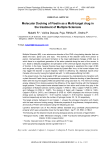
Molecular docking of fisetin as a multi-target drug in the treatment of multiple sclerosis
Статья научная
Multiple Sclerosis (MS), is an autoimmune disorder of the CNS a long-lasting disorder that can attack the brain, spinal cord, and eyes. The severity of this disorder varies from person to person. Demyelination and lesion formation is the major pathological changes of MS, due to which there is no significant generation of the action potential along the axon of the nerves. In turn, leads to delayed propagation and perception of the chemical signals required for varieties of function in the body. Several theories have been emerging to apprehend the origin of MS such as genes, smoking, viral infection caused by Epstein-Barr virus, or the human herpes virus may trigger the disorder or cause relapses, Vitamin D deficiency etc. Statistical reports show Canada is the country having the highest rate with 1 in 400 people suffering from MS. In the present study, the drug targets of MS were analyzed by understanding its interaction with a plant flavonoid Fisetin having neuroprotective properties. Molecular docking of plant flavonoid fisetin with the enzyme targets of MS was performed using auto-dock 4.2. The minimum binding energy obtained from docking explains the efficiency of the ligand binding with the therapeutic target proteins. Three proteins were selected based on their action and function they play in the progression of Multiple sclerosis namely Caspase 1 (PDB Id: 1lBC), Calpain-1(PDB Id: 2ARY), and Cathepsin B (PDB Id: 1GMY). The docking of fisetin with Caspase 1 (PDB Id: 1lBC), Calpain-1(PDB Id: 2ARY), and Cathepsin B (PDB Id: 1GMY) displayed the minimum binding energy score as, Cathepsin B = -10.01 kcal/mol, Calpain-1= -9.95 kcal/mol, Caspase 1= -8.18 kcal/mol respectively and also the number of hydrogen bonds: 20, 18, 23 respectively. The target proteins Cathepsin B and Calpian 1, showed the strongest interaction with Fisetin with the least minimum binding energy. Molecular properties & drug-likeness, biological activity, and toxicity of Fistein were analyzed using the Way2drug bio tool. Lipinski's benchmark rule of five (RO5)5 defines desirable drug candidate physicochemical property which was successfully shown by the ligand fistein : log P:1.35, HBD: 4, HBA:6 The following are the obtained results showing biological activity and toxicity of ligand fistein: • Biological Activity: 0.966- Membrane intergrity; 0.959- Aryl-alcohol dehydrogenase (NADP+) inhibitor; 0.950- kinase inhibitor • Toxicity: Vascular toxic (0.755 pa), ulcer, aphthous (0.713 pa). where pa [pharmacologically active] is greater than 0.7.
Бесплатно
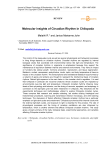
Molecular insights of circadian rhythm in Chilopoda
Статья обзорная
The control of the sleep-wake cycle as well as several physiological and behavioral processes in living things depends on circadian rhythms. Circadian rhythms are regulated by internal biological clocks that coordinate with environmental stimuli like light and temperature. The significance of circadian rhythms in organisms is emphasized because they support the maintenance of equilibrium between internal and external environments. They have an impact on functions like cellular growth, hormone production, reproduction, and tissue regeneration. Melatonin, cortisol, vasopressin, acetylcholine, insulin, leptin, and body temperature all have an impact on the circadian rhythm. The transcriptional and translational feedback loops formed by a network of genes and proteins are thought to represent the biochemical basis of circadian rhythms. Retinal light exposure is the main factor in the circadian clock's regulation. It is said that Chilopods in particular are nocturnal creatures whose circadian cycles are impacted by environmental cues like light and temperature. Chilopods' circadian rhythms influence many facets of their physiology and behavior, and the timing of necrosis, apoptosis, and autophagy in connection to the day/night cycle has been researched in Chilopods. Also described are the experimental techniques and methodologies utilized to explore Chilopoda circadian cycles. These comprise field research and sample collecting, lab studies utilizing histological and histochemical procedures, scanning and transmission electron microscopy, and other staining techniques. The discussion of factors affecting Chilopoda circadian rhythms has a particular emphasis on light-dark cycles and entrainment. Chilopods synchronize their internal clocks with the external light-dark cycles, and exposure to light is essential for this process. The rate of physiological processes and the timing of circadian oscillations are also influenced by temperature, which is another element that affects Chilopoda circadian rhythms. This study gives a broad summary of the traits, biological basis, experimental approaches, and variables affecting Chilopoda circadian rhythms.
Бесплатно
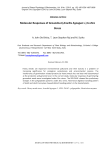
Molecular responses of groundnut ( Arachis hypogea L.) to zinc stress
Статья научная
Heavy metals are important environmental pollutants and their toxicity is a problem of increasing significance for ecological, evolutionary and environmental reasons. The interference of germination related proteins by heavy metals has not been well documented at the proteomic and genomic level. In the current study, molecular responses of germinating groundnut seeds were investigated under Zinc stress. The SDS-PAGE showed the preliminary changes in the polypeptides patterns under Zinc stress. Restriction digestion banding pattern of EcoRI and Hind III enzymes showed distinct banding pattern in the treated plants.
Бесплатно
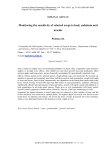
Monitoring the sensitivity of selected crops to lead, cadmium and arsenic
Статья научная
Heavy metals are highly toxic environmental pollutants. In plants, these compounds cause numerous slighter or stronger toxic effects. They inhibit root and shoot growth and yield production, affect nutrient uptake and homeostasis, and are frequently accumulated by agriculturally important crops. Effects of heavy metals on five selected species of agricultural crops were monitored. We focused our attention to general and commonly used stress indicators such as seed germination, weight and length of roots and shoots. Each of these characteristics was dependent on the tested plant species and tested heavy metals. Dosage of lead (500 mg/l) had little effect on seed germination, cadmium (300 mg/l) significantly affected seed germination of pea and barley, arsenic (100 mg/l) caused total inhibition of seed germination in all tested plant species. Plants grow in soil contaminated with heavy metals showed several symptoms of metal toxicity (chlorosis, necrosis of leaf tips, blackening of roots). In general, the highest tolerance to tested metal ions was observed in both varieties of bean, and the lowest sensitivity was observed in soybean plants. The highest degree of toxicity was shown to have tested doses of cadmium and arsenic, the lowest the doses of lead. In general, the lowest tolerance indexes were determined based on the decrease in fresh weight of roots.
Бесплатно
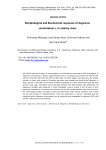
Morphological and biochemical responses of Aegiceras corniculatum L. to salinity stress
Статья научная
Salt (NaCl) induced changes of morphological and biochemical parameters were investigated in Aegiceras corniculatum L. Blanco supplemented with an increasing concentration of NaCl (0 mM, 100 mM, 150 mM, 200 mM, 250 mM and 300 mM). The plant height, stem diameter, dry weight, number of leaves and number of branches per plant were studied and found to be maximum in plants grown in 250 mM concentration of NaCl comparable to others. Biochemical test like total protein, total sugar, chlorophyll and carotenoid contents from leaf samples were performed. No significant changes were observed in total chlorophyll content among 0 and 30 days of NaCl treatment, however an increment was noticed in all the salt treated samples than that of control. The total soluble protein and sugar content were decreased under salinity condition even in both the 30 and 60 days of supplementation. From this experiment it may be concluded that the mangrove plant Aegiceras corniculatum can be sustained and propagated in optimum (250 mM) salinity under green house condition.
Бесплатно
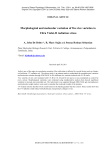
Morphological and molecular variation of five rice varieties to ultra violet-B radiation stress
Статья научная
India is one of the major rice producing countries. Rice cultivation is affected by several factors such as climate, soil pollution, UV radiation etc. The present study is an attempt made to understand the morphological variation and molecular variation through SDS-PAGE in five different rice varieties induced with UV-B stress. Five varieties of rice were irradiated with UV-B for 10, 20 and 30 min and a set was maintained as control for every variety. Morphological variations were estimated using morphometric analysis that showed significant variation in stressed and controlled sets. The leaf protein was separated through SDS-PAGE gel electrophoresis and molecular weight markers were used to calculate the molecular weight of the proteins. UV treated varieties had the lowest record based on the banding pattern than the control. These results show that the UV radiation could induce both phenotypic and genotypic changes in rice.
Бесплатно
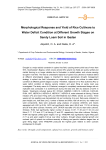
Статья научная
Drought is a major abiotic constraint in upland rice field, causing severe yield loss of more than 50%. Southwestern Nigeria, which covers almost 30% upland rice fields are purely rainfed and rainfed farming is no longer reliable due to fluctuation in rainfall pattern and volume causing drought in rice field. The need to understand response of upland rice cultivars to moisture deficit at different phenological stages is important to device appropriate drought management strategy in upland rice field. Information on response of upland rice cultivar to water deficit condition at different growth stages is scanty. Therefore, response of 12 Rice Cultivars (RC) to water deficit condition at tillering, panicle initiation and grain filling on sandy loam was investigated. The study was a 4×12 factorial, arranged in completely randomized design with six replicates was conducted in a screenhouse during the early and late dry seasons of 2018 in Ibadan. Treatments included twelve RC: OFADA, IGBEMO, FARO-16, FARO-44, FARO-60, IR-64, APO, NERICA-4, NERICA-5, NERICA-7, NERICA-8, water stressed at tillering, Panicle Initiation (PI) and Grain Filling (GF) and Well-Watered Soil (WWS, served as control). Three weeks old rice seedling was transplanted into pot containing 5 kg soil. Data were collected on plant height (cm), leaf area (cm2), number of leaves and tillers, leaf roll and dry, dry matter and yield components. Data were analyzed using analysis of variance (ANOVA) and means separated with LSD (p function show_abstract() { $('#abstract1').hide(); $('#abstract2').show(); $('#abstract_expand').hide(); }
Бесплатно
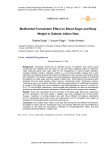
Multiherbal formulation effect on blood sugar and body weight in diabetic albino rats
Статья научная
Background: Therapeutic plants are an important source of medicine, and various active compounds were isolated from the plants. As per the Indian traditional system of medicine, many medicinal plants have been used for the management of various health disorders, including diabetes mellitus . Diabetes mellitus is a non-communicable disease that is also referred to as a lifestyle disorder that requires modifications in diet, exercise, and behavior along with medication. The present research work was designed to evaluate the impact of multiherbal formulations on blood sugar and body weight in albino rats. Three different formulations were prepared from five plant extracts ( Allium sativum, Azadirachta indica , Phyllanthus emblica, Tamarindus indica, and Zingiber officinale ). After daily administration of multiherbal formulations at a dose of 300 mg/kg b.wt. and the standard drug (Glibenclamide) at a dose of 5 mg/kg b.wt. for 15, 30, and 45 days, respectively, blood samples were collected from each rat and analyzed according to standard techniques (parameters). Blood sugar and body weight were measured.
Бесплатно
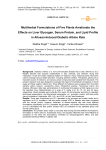
Статья научная
Background: Diabetes mellitus is a non-communicable disease that is also referred to as a lifestyle disorder that requires modifications in diet, exercise, and behavior along with medication. As per the Indian traditional system of medicine, many medicinal plants have been used to manage various health disorders, including diabetes mellitus . Therapeutic plants are an important source of medicine, and various active compounds were isolated from the plants. The present research work was designed to evaluate the impact of multiherbal formulations on blood sugar and body weight in albino rats. Three different formulations were prepared from five plant extracts ( Allium sativum, Azadirachta indica , Phyllanthus emblica, Tamarindus indica, and Zingiber officinale ). After daily administration of multiherbal formulations at 300 mg/kg b.wt. and the standard drug (Glibenclamide) at a dose of 5 mg/kg b.wt. for 15, 30, and 45 days, respectively. Blood samples were collected from each rat and analyzed according to standard techniques (parameters), and biochemical parameters, viz., glycogen, protein, and lipid profile (serum cholesterol, triglyceride, HDL, LDL, and VLDL) of rats, were measured.
Бесплатно
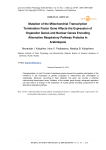
Статья научная
Characterization of mterf13 mutant Arabidopsis plants showed the possible participation of the mTERF13 in the modulation of genetic processes in mitochondria and chloroplasts of Arabidopsis. Moreover, according to data obtained, this gene can encode a potential mitochondrial transcription factor. Mutation of the studied gene through retrograde regulation can also lead to a change in the expression of nuclear genes encoding components of the alternative respiratory pathway.
Бесплатно
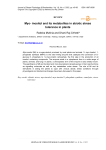
Myoinositol and its metabolites in abiotic stress tolerance in plants
Статья обзорная
Myo -inositol (MI) is a sugar-alcohol produced by most plants and animals. 1L-myo-Inositol- 1-phosphate synthase (MIPS) is the rate limiting enzyme that catalyzes the conversion of D-glucose 6- phosphate to 1L-myo-inositol-1-phosphate, the first step in the production of all inositol- containing compounds. The enzyme exists in a cytoplasmic form in a wide range of plants, animals, and fungi. In plants, a chloroplastic form of the enzyme is also widely known. The significance of MI and its direct and more downstream derivatives lies in their dual functions as signalling molecules as well as key metabolites under stress. The role of MI and its derivatives in aiding the plants to cope with various abiotic stress conditions through physiological and biochemical changes have been discussed in this paper.
Бесплатно

